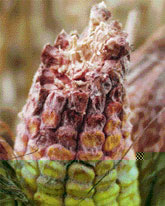Traditionally An Eye On Ears
by Greg Stewart, OMAFRA Corn Specialist
|
|
|
Figure
1
Giberella ear rot infection usually occurs from the tip down. Note
the dark pink to red colour. |
Ear mould on
corn has been a long-time concern to corn growers within the province, especially
those that feed the vast majority of their corn to livestock. The conditions
that lead to ear mould problems in the grain are not very well understood.
The last significant occurrence of ear mould was in 1999. This was a surprise
to most since that growing season was dominated by hot dry conditions and
not the type of weather we would expect to foster ear mould growth.
Although the reasons for these sporadic and sometime unexpected ear mould
outbreaks are unclear it may be related to one or all of the following:
1) poor ear fill, predisposing the ear to infection
2) heat and drought stress
3) a large number of foggy or mist-filled mornings in August and September
(moisture enhances infection possibilities)
4) ear damage by insects creating infection entry points
As I write this article, about the only thing that I am sure of is that
in the 2003 growing season we had more than our share of high humidity and
foggy mornings during the pollination and early grain–fill period.
Insect and bird activity on the ears was perhaps slightly higher than normal
as well.
Hopefully, dry conditions in September and on into the harvest season will
suppress any mould growth. However, as a precaution, corn producers are
advised to scout fields for ear mould. Fields should be first targeted for
scouting where the crop has been under more stress than normal, or where
insect or bird damage had been noticed earlier in the season. You may also
consider targeting fields where wheat was grown last year as having the
potential for greater infection. Scouting 5 fields may reveal 4 mould-free
fields and one with severe mould. Infection in fields is sporadic, often
field specific. In addition, some hybrids appear more prone than others
to fusarium. In fields where there is no mould growth there is no risk of
mycotoxin production.
The most common and important ear mould in Ontario is Gibberella zeae, which
is the sexual reproductive stage of Fusarium graminearium. This fungus not
only infects corn but also small grains such as wheat, where it causes Fusarium
Head Blight.
Although, the Gibberella fungus can produce a white mould that makes it
difficult to tell apart from Fusarium ear rot, the two can be distinguished
easily, when Gibberella produces its characteristic red or dark pink (purple)
mould (Figure 1).
Infection begins through the silk channel and thus, in most cases starts
at the ear tip. In severe cases, most of the ear may be covered with mould
growth. Corn silks are most susceptible 2-10 days after initiation, and
hence the concern over cool, wet or high humidity weather during this period.
Gibberella ear rot is economically important not only because of the potential
yield and quality losses but because Gibberella zeae and Fusarium graminearum
produce two very important mycotoxins that occur in Ontario - deoxynivalenol
(vomitoxin or DON) and zearalenone. These mycotoxins are especially important
to swine and other livestock producers since they can have a detrimental
effect on their animals. Feed containing low levels of vomitoxin (1 ppm)
can result in poor weight gain and feed refusal in swine. Zearalenone is
an estrogen and causes reproductive problems such as infertility and abortion
in livestock, especially swine. Feed grain that originated in a field with
5% or more Gibberella ear rot should be tested for these toxins.
If you encounter mould problems, it does not necessarily mean that the mycotoxins
(i.e. vomitoxin, zearalenone, fumonisin, T-2) produced by the moulds are
present yet in the grain. The likelihood of mycotoxin production increases
on corn where the mould is deep pink or purple in colour. Samples should
be taken and sent to a lab for mycotoxin analysis. Also remember, mycotoxins,
depending on their concentrations in the feed can be readily detected on
the farm. Zearalenone in feed eaten by eight week old gilts will cause redness
and swelling of the vulva in 4 to 10 days. Similarly, vomitoxin or T-2 may
result in noticeably reduced feed intake in 8-week-old piglets after just
a few days on the infected feed.
Harvest Precautions
to Minimize Impact of Fusarium Infected Corn
There are
several precautions that can be undertaken during harvest to reduce the
impact of fusarium infected corn.
1. First, harvest infected fields early. Mycotoxin levels have the potential
to build the longer you leave the corn in the field. Once corn moisture
is below 18%, the fusarium fungus is dormant and ceases to produce mould.
2. High temperature drying stops mould growth and mycotoxin production
but does not reduce mycotoxins already present. Quick drying is preferred
over low heat drying. Be wary of low temperature in bin dryers for mouldy
corn and be sure proper ventilation requirements are met for storing dry
corn. Keep in mind that there is moisture variability across the field,
therefore, wet pockets above 18% moisture can still produce moulds.
3. Set the combine to provide high levels of wind to blow out the lighter
infected kernels. The fusarium fungus results in lower kernel stability,
resulting in higher incidence of mycotoxins in fines (kernel tips and
red dog) and cob pieces.
4. Sacrifice the tip kernels by running the combine at full capacity with
concave settings wide open and cylinder speed set low. Screens on the
bottom of the grain elevator, the bottom of the return elevator and on
the unload auger will also help screen out the fines.
5. In corn silage, the acids produced during proper ensilage will stop
the growth of moulds. Where there is improper fermentation, moulds could
continue to produce mycotoxins and lead to higher toxin levels that could
affect cattle.
Back
to Top

